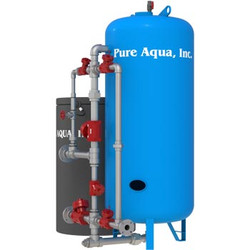What Is A Water Softener
Posted by Pure Aqua, Inc. on Oct 18th 2019
A water softener system is a unit that is used to soften water, by removing the minerals that cause the water to be hard. Water softening is an important process, because the hardness of water in different applications is reduced during this process. Water softening is a key step in treating hard or raw water. Without this step, minerals and materials in raw water such as calcium, magnesium and various others can build up to damage the water treatment equipment; specifically the membranes used to clean water. Removal of these materials can be achieved by ion exchange systems.
Water Softening Process
This process involves calcium and magnesium ions being switched for sodium or potassium ions. Inside the softener, an ion exchange material, such as a bed of small, plastic resin beads or zeolite, is saturated with sodium or potassium chloride. The material draws in calcium and magnesium, which displace the sodium or potassium into the water. When the material is completely covered through exchange, a solution washes away the removed minerals and replaces the regenerate ions before the tank is rinsed with fresh water. This process is known as regeneration.
The ion exchange process in your water softener reduces hardness while also recharging the system through another ion exchange in the brine solution. Although your water softener will keep working with minimal maintenance from the user, it is recommended that you have it inspected on a regular basis for routine maintenance.
What is a Water Softener Used For?
When water is hard, it can clog pipes, damage boilers, heat exchangers, and many other devices. Water softening can prevent these negative effects. Hard water causes a higher risk of lime scale deposits in residential, commercial and industrial water treatment systems. Due to this lime scale build-up, pipes are blocked and the efficiency of hot boilers and tanks is reduced. This increases the cost of domestic water heating by about fifteen to twenty percent.
Another negative effect of lime scale is that it has damaging effects on household machinery, such as laundry machines. Water softening using Pure Aqua water softener system expands the life span of each household machine, such as laundry machines, and the life span of pipelines. It also contributes to the improved working, and longer lifespan of solar heating systems, air conditioning units and many other water-based applications.
How to Size a Water Softener
How to size a water softener? A softener is sized on the basis of two different parameters, i.e. Exchange capacity, that is the quantity of water delivered between regenerations, and maximum flow rate, which is the maximum quantity of water required at any peak usage period.
Our industrial water softener (SF-100S Series) softeners are designed as fully automatic units either with timer or meter control. The timer control initiates softener regeneration at any predetermined time - on any or every day. The metered models start regeneration based on the total gallons used.
The steel mineral tank is engineered for a 100 psi working pressure and is tested to 150 psi. It is equipped with a manhole in the upper dome.
The interior of the tank is coated with epoxy for protection against rust and corrosion. The exterior has a rust-inhibiting primer coat.
A premium grade sulfonated nonphenolic polystyrene type resin is contained in the mineral tank. The resin will deliver 30,000 grains per cubic foot when brined at a rate of 15 lbs. per cubic foot.
The brine tank is a combination of high-density polystyrene brine measuring tank and a brine valve, including an air eliminator valve and a safety brine refill shut off to prevent tank overflow.
The automatic regeneration controller features a choice of 7 or 12-day calendar wheels. The time of regeneration and length of time for each regeneration cycle is fully adjustable.
The underdrain utilizes either a hub & lateral or a header & lateral system to evenly distribute water and prevent resin loss and to ensure minimal pressure drop at peak flow rates.
 ENGLISH arrow_drop_down
ENGLISH arrow_drop_down
 ESPAÑOL
ESPAÑOL ???????
??????? PORTUGUÉS
PORTUGUÉS FRANÇAIS
FRANÇAIS

